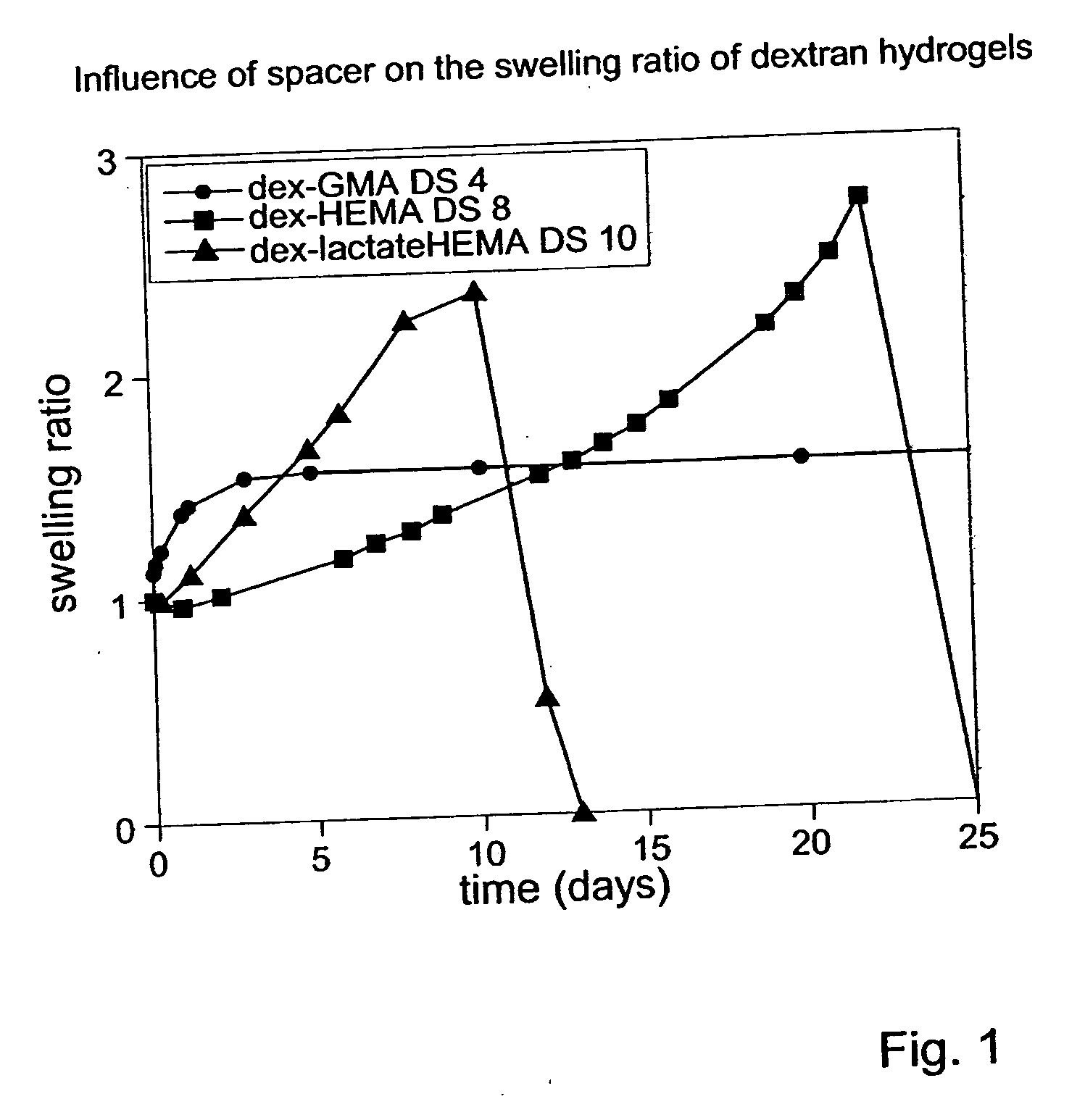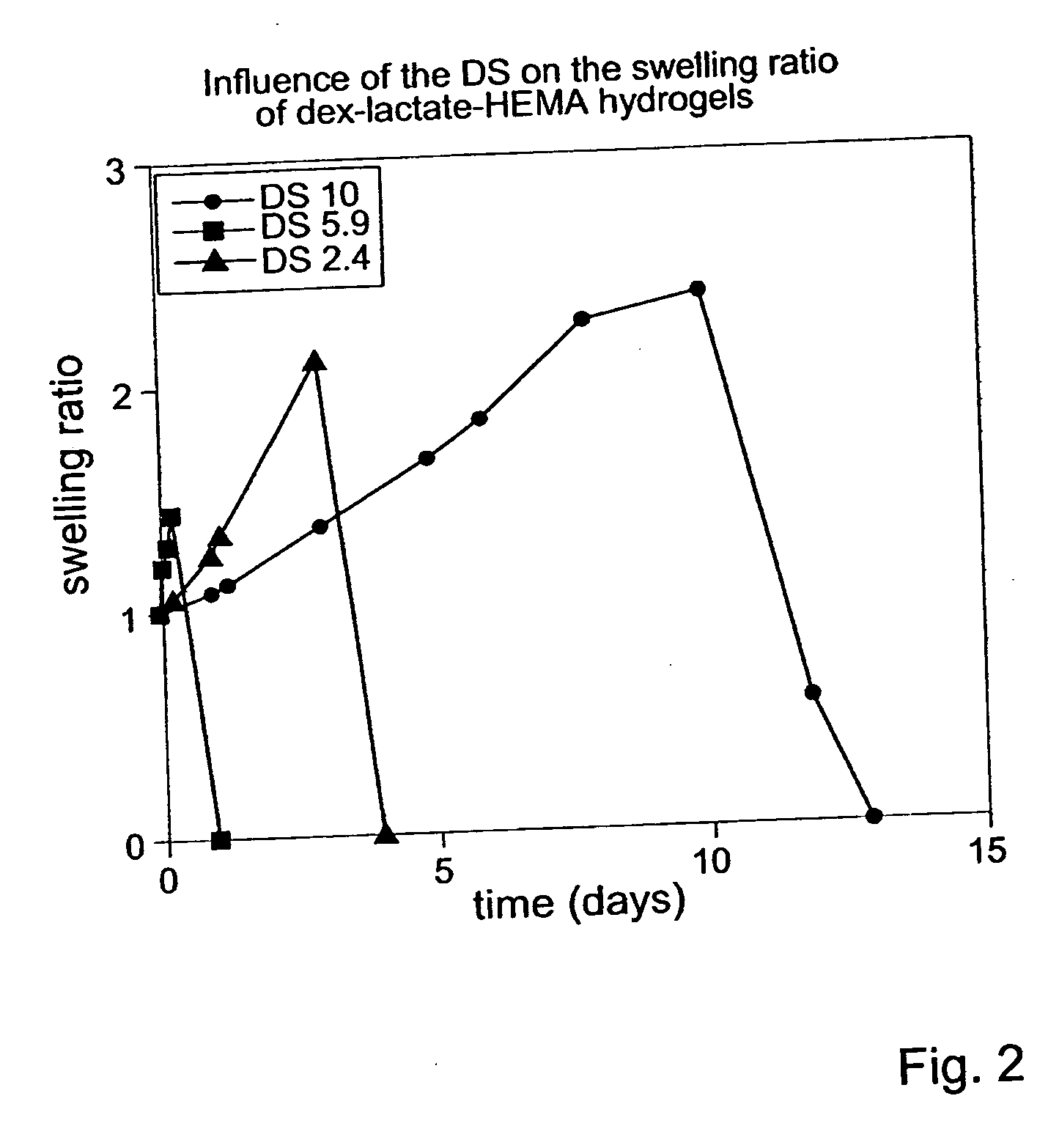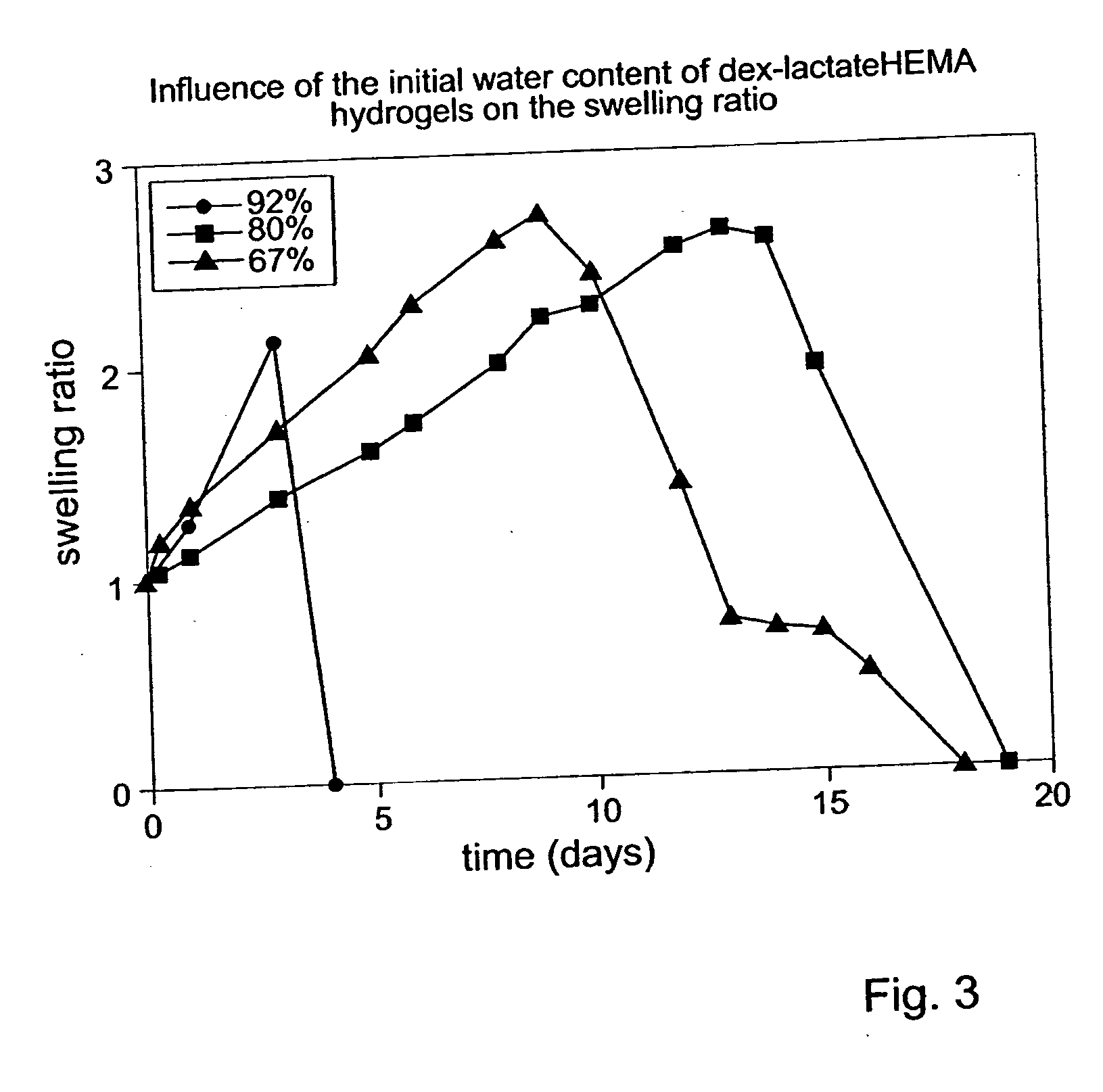Biodegradable hydrogels
a biodegradable, hydrogel technology, applied in the field of prepolymers, can solve the problems of inability to pass endothelial and epithelial barriers, protein drugs cannot be injected per se, and products tend to degrade rapidly in the gastrointestinal tract, and achieve poor controllable release behavior
- Summary
- Abstract
- Description
- Claims
- Application Information
AI Technical Summary
Benefits of technology
Problems solved by technology
Method used
Image
Examples
example 1
Synthesis of Dex-HEMA
[0084]Dextran derivatized with hydroxyethyl methacrylate (dex-HEMA) was synthesized by coupling carbonyldiimidazole (CDI) activated HEMA (HEMA-CI) to dextran.
[0085]CDI (1.62 g; 10 mmol) was dissolved in about 10 ml anhydrous tetrahydrofuran (THF). This solution was added to a solution of HEMA (1.30 g; 10 mmol) in 5 ml anhydrous THF. The reaction mixture was stirred for 16 hours at room temperature. After evaporation of the solvent a slightly yellow liquid was obtained (yield 2.93 g). The crude product was dissolved in ethyl acetate, extracted with water to remove imidazole and unreacted HEMA and dried on anhydrous MgSO4. After filtration, the solvent was evaporated and almost pure hydroxyethyl methacrylate activated with CDI (HEMA-CI) was obtained. The structure of this product was confirmed by NMR and IR spectroscopy.
[0086]Varying amounts of HEMA-CI (0.73, 1.49, or 2.19 g; 96% pure) were added to a solution of dextran (10 g, 62 mmole glucose units) and N,N-dime...
example 2
Synthesis of Dex-SA-HEMA
[0087]Dextran derivatized with the hemi-ester of succinic acid (SA) and HEMA (dex-SA-HEMA) was synthesized as follows.
[0088]SA (2.00 g, 20 mmol), HEMA (2.6 g, 20 mmol), triethylamine (TEA; 0.28 mL 2 mmol) and hydroquinone (inhibitor, + / −10 mg) were dissolved in about 30 ml anhydrous THF. The reaction mixture was stirred for 2 days at 45° C., after which the solvent was evaporated. A yellow liquid was obtained (yield 4.88 g). The structure of HEMA-SA was confirmed by NMR and IR spectroscopy.
[0089]HEMA-SA (0.99 g (94% pure), 4 mmol) and dicyclohexylcarbodiimide (DCC; 0.83 g, 4 mmol) were dissolved in about 20 ml anhydrous DMSO. After 15 minutes a precipitate was formed (dicyclohexylureum; DCU) and this mixture was added to a solution of dextran (2.57 g, 16 mmol glucose units) and TEA (0.56 mL 4 mmol) in anhydrous DMSO (20 ml). The resulting mixture was stirred for 3 days at room temperature, after which 3 drops of concentrated HCl were added to terminate the re...
example 3
Synthesis of Dex-Lactate-HEMA
[0090]Dextran derivatized with HEMA-oligolactide was synthesized as follows as illustrated in scheme l. Three steps can be distinguished.
[0091]a. coupling of lactate to HEMA yielding HEMA-lactate;
[0092]b. activation of HEMA-lactate using CDI yielding HEMA-lactate-CI
[0093]c. coupling of HEMA-lactate-CI to dextran.
[0094]A mixture of L-lactide (4.32 g; 80 mmol) and HEMA (3.90 g; 30 mmol) was Heated to 110° C. Thereafter, a catalytic amount of stannous octoate (SnOct2; 121.5 mg, 0.3 mmol) dissolved in about 0.5 ml toluene was added. The resulting mixture was stirred for 1 hour. After cooling down to room temperature, the mixture was dissolved in THF (20 ml). This solution was dropped in water (180 ml) and the formed precipitate was isolated by centrifugation. The pellet was taken up in ethyl acetate (40 ml), centrifuged to remove solid material, dried (MgSO4) and filtered. The solvent was evaporated yielding a viscous oil (3.74 g, 45%). The product (HEMA-lac...
PUM
| Property | Measurement | Unit |
|---|---|---|
| Solubility (mass) | aaaaa | aaaaa |
| Molecular weight | aaaaa | aaaaa |
| Cytotoxicity | aaaaa | aaaaa |
Abstract
Description
Claims
Application Information
 Login to View More
Login to View More - R&D
- Intellectual Property
- Life Sciences
- Materials
- Tech Scout
- Unparalleled Data Quality
- Higher Quality Content
- 60% Fewer Hallucinations
Browse by: Latest US Patents, China's latest patents, Technical Efficacy Thesaurus, Application Domain, Technology Topic, Popular Technical Reports.
© 2025 PatSnap. All rights reserved.Legal|Privacy policy|Modern Slavery Act Transparency Statement|Sitemap|About US| Contact US: help@patsnap.com



